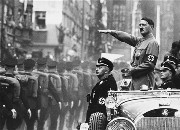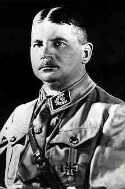![]()
Chapters
Turning Point
 Adolf Hitler - Leader of the Nazi Party  Hitler (standing) at a Nazi Party Rally - 1920's  Ernst Rohm - Leader of the SA and longtime Hitler ally turned scapegoat in the Night of the Long Knives |
Many Germans initially welcomed Hitler and the Nazis into Power. The ineffectiveness of the Weimar Republic to deal with the staggering rates of unemployment and lowering values of the Reich mark helped speed Hitler into the Chancellor’s Office. Claus Stauffenberg was no exception. He was accepting of the Nazi political platform which called for, “…removing the restrictions on national sovereignty imposed by the Versailles Treaty, of ending reparations, of re-armament to a level comparable to that of other great nations, of soldierly values, of Volksgemeinschaft (community), of an end to political strife, of order and integrity in administration and every day life as well."[7] These thoughts were not solely the intellectual property of the Nazis for many Germans had felt this way for years. This “volkish” (people) concept of a community working together for the common benefit was something that many Germans could relate to. However a person such as Stauffenberg with his aristocratic upbringing and value system was not as easily swayed by Hitler as many of his countrymen were. Two instances in particular in the pre war years of Hitler’s Germany helped change Stauffenberg’s initial perceptions of National Socialism from one of skeptical acceptance to outright hatred. The first incident occurred in 1934 not long after Hitler rose to power and was known in Germany as the Rohm affair or, more contemporarily as, “The Night of the Long Knives.” Ernst Rohm was the leader of the Sturmabteilung or SA which was the Nazi Party’s semi-private army. Tension between the Reichswehr and the SA had been mounting since Hitler’s rise to power due to the fact Rohm wished the SA to become the new German army. This tension came to a head on June 30th, 1934 when Hitler had Rohm, as well as other leaders of the SA, arrested and shot.The actions of Hitler this night did not turn Stauffenberg away from Nazism completely. He was certainly not a supporter of Rohm or his plans for the SA. According to his wife he viewed the situation, “…as the lancing of a boil, as a result of which there would be some clarity in the direction of affairs."[8] He did come to realize that the way in which Rohm and his men were dispatched was a harbinger of dark times for the future of Germany. Even though Hitler had proclaimed that he only undertook this task in emergency defense of the state this could not belie the fact that Germany was now under the rule of men who held no concept of the normal rules of justice.
The
second incident occurred in 1938 and strongly shifted
Stauffenberg’s support away from Hitler. It all started when a
minor embassy official in Paris was killed by a Jew in
retaliation for the harsh treatment of his family in Germany.
The Nuremburg Laws enacted in 1935 had severely limited the
Jewish population in Germany from enjoying a comfortable life
since and the restrictions were only getting worse. Site designed and maintained by Bill Jeffers Public History at the University of North Carolina at Charlotte
|
